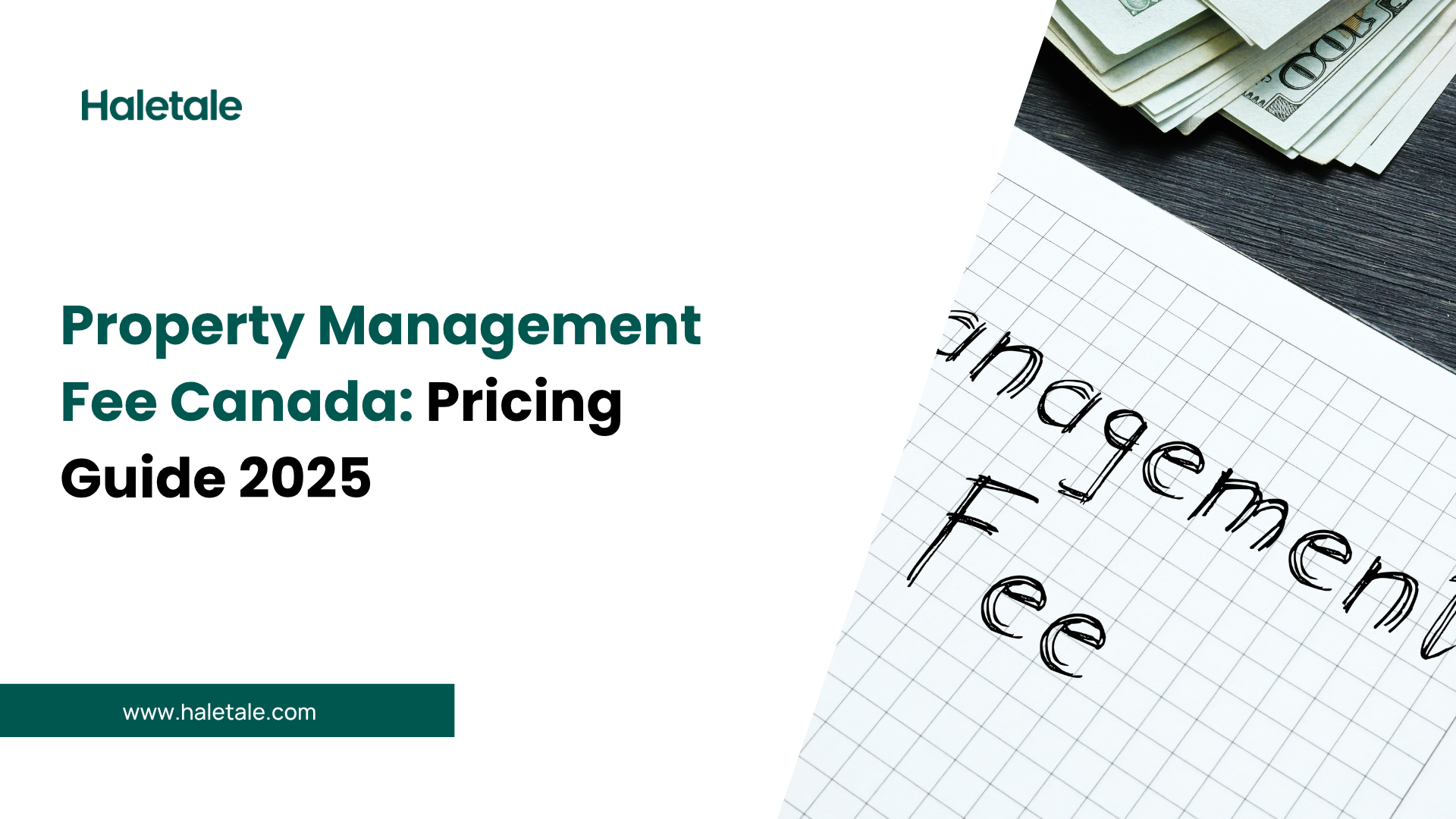Property Management Fee Guide: How to Price Your Services Competitively in Canada
Property management companies in Canada typically charge 8-12% of monthly rent for residential properties, with additional fees for tenant placement (50-100% of one month’s rent), setup ($300-500), maintenance coordination (5-15% markup), and lease renewals ($200-500). GST/HST applies to all services and must be collected and remitted. Understanding competitive pricing across provinces, clearly communicating your value proposition, and structuring transparent fee schedules are essential for attracting and retaining clients. Property managers who can demonstrate ROI through reduced vacancies, quality tenant screening, legal compliance, and time savings justify premium pricing. This guide helps property management companies benchmark their fees, structure service packages, and effectively communicate their value to prospective landlords.
Pricing Your Property Management Services
As a property management professional, one of your biggest challenges is pricing your services competitively while ensuring profitability. Price too high, and you’ll lose clients to competitors. Price too low, and you’ll struggle to deliver quality service or make a reasonable profit.
The question isn’t just “What should I charge?” It’s “How do I price my services to reflect the value I provide while remaining competitive in my market?”
This guide will help you understand the current property management fee landscape across Canada, benchmark your pricing against competitors, structure your fee packages effectively, and—most importantly—communicate your value to prospective clients who are comparing quotes.
Whether you’re launching a new property management company or reevaluating your existing fee structure, this comprehensive breakdown will help you make informed pricing decisions. And if you want to provide your prospective clients with a transparent way to estimate your fees, direct them to our property management fee calculator to show them exactly what they’ll pay.
Understanding Standard Property Management Fee Structures
Before setting your prices, you need to understand the three main fee structures used in the Canadian property management industry.
Percentage-Based Monthly Management Fee
This is the most common pricing model, where you charge 8-12% of the monthly rent collected.
Why landlords prefer this model:
- They only pay when you collect rent
- Your success is tied to keeping properties occupied
- Fees scale naturally with property value
Why you should consider this model:
- Incentivizes you to maximize rental income
- Easier to justify rate increases as market rents rise
- Predictable revenue when properties are occupied
- Industry standard that clients expect
Pricing considerations:
- Higher-rent markets (Toronto, Vancouver) can justify 8-10% due to property values
- Lower-rent markets may require 10-12% to cover your costs
- Portfolio clients may negotiate volume discounts (8% for 5+ properties)
Flat Monthly Fee
Some property managers charge a fixed monthly rate (typically $100-300 per property) regardless of rental income.
When to use flat fees:
- High-value properties where percentage fees seem excessive
- Properties with extremely low rents where percentages don’t cover costs
- Clients who prefer predictable expenses
Challenges with flat fees:
- Less motivation for clients to see you maximize rents
- Doesn’t scale with property value or inflation
- May need annual adjustments to maintain profitability
Hybrid or Tiered Pricing
Some property managers use hybrid models combining percentage and flat fees, or tiered pricing based on service levels.
Examples:
- 8% for full service, 5% for rent collection only
- $150/month + 5% of rent collected
- Tiered packages: Basic, Standard, Premium
This allows you to serve different client segments while maintaining profitability across service levels.
Complete Fee Structure Breakdown for Property Managers
Here’s how to structure all the fees your property management business should consider charging. Remember: all fees must include GST/HST as per CRA requirements.
Setup or Onboarding Fee: $300-500 + GST/HST
What this covers:
- New client account setup in your management system
- Property inspection and documentation
- Creating accounting ledgers
- Setting up online payment portals
- Initial property photos and listing setup
- Lease agreement review or creation
Pricing strategy: This one-time fee covers your administrative costs and initial property assessment. Some managers waive this for multi-property clients or long-term contracts.
Monthly Management Fee: 8-12% + GST/HST
What this covers:
- Rent collection and deposit processing
- Monthly financial reporting
- Tenant communication and request management
- Maintenance coordination (minor items)
- Regular property oversight
- Legal compliance monitoring
- Monthly owner statements
Pricing strategy: This is your recurring revenue base. Price it to ensure sustainability while remaining competitive in your market.
Tenant Placement/Leasing Fee: 50-100% of One Month’s Rent + GST/HST
What this covers:
- Professional marketing and photography
- Listing on major rental platforms (Kijiji, Realtor.ca, Rentals.ca)
- Showing coordination
- Application processing
- Credit and background checks (Equifax/TransUnion)
- Employment and reference verification
- Lease preparation and signing
- Move-in inspection and documentation
Pricing strategy: This is one of your highest-value services. Quality tenant placement can save owners thousands in vacancy costs and problem tenants. Don’t undervalue this service—it’s worth 75-100% of one month’s rent.
Lease Renewal Fee: $200-500 + GST/HST
What this covers:
- Renewal negotiation with tenant
- Market rent analysis
- New lease agreement preparation
- Updated documentation
Pricing strategy: This is significantly less work than new tenant placement, but still requires professional handling. Price accordingly—typically 25-50% of your full placement fee.
Vacancy Fee: Variable or None
Options:
- No fee during vacancy (most common)
- Reduced flat fee ($100-150/month)
- Reduced percentage (50% of normal monthly fee)
Strategy consideration: Most property managers don’t charge during vacancies to keep themselves motivated to fill units quickly. However, if you’re actively marketing and showing, a reduced fee may be justified.
Maintenance Coordination: 5-15% Markup + GST/HST
What this covers:
- Contractor coordination and scheduling
- Work quality oversight
- Multiple quotes for major repairs
- Emergency response management
- Warranty and documentation management
Pricing strategy: Your markup compensates for the time spent coordinating repairs. Many owners accept 10% as standard. Alternatively, charge a flat coordination fee ($50-100) for each work order.
Property Inspection Fee: $100-200 per Inspection + GST/HST
What this covers:
- Thorough property walkthrough
- Photo documentation
- Detailed written report
- Maintenance recommendations
Pricing strategy: Some managers include 1-2 annual inspections in the monthly fee and charge for additional ones. Others charge for all inspections separately. Be clear about what’s included.
Eviction Management Fee: $500-1,000 + GST/HST
What this covers:
- Filing paperwork with LTB/RTB
- Evidence gathering and documentation
- Hearing attendance
- Coordinating with legal counsel if needed
Note: This doesn’t include LTB/RTB filing fees or paralegal/lawyer costs, which are passed through to the owner.
Pricing strategy: Evictions are time-intensive and stressful. Price this to reflect the significant work involved.
Additional Fees to Consider
Project Management Fee: 10-15% of project cost for major renovations or turnovers
Late Fee Collection: Keep 25-50% of late fees collected from tenants
Early Termination Fee: Charge remaining months on contract or 1-2 months’ management fees
NSF Fee: $25-50 for bounced payments from owners
Document Preparation: $50-100 for addendums, notices, or special documents
After-Hours Emergency Call-Out: $75-150 for non-emergency after-hours requests
GST/HST Requirements for Property Management Companies
As a Canadian property management business, you must understand and comply with GST/HST regulations.
You Must Collect GST/HST On:
- All property management fees
- Tenant placement fees
- Inspection fees
- Coordination fees
- All services you provide
GST/HST Rates by Province:
- 5% GST: Alberta, BC, Manitoba, NWT, Nunavut, Quebec, Saskatchewan, Yukon
- 13% HST: Ontario
- 15% HST: New Brunswick, Newfoundland and Labrador, Nova Scotia, PEI
Important Compliance Notes:
- You must register for GST/HST once your revenues exceed $30,000
- Always quote prices with GST/HST clearly indicated
- Remit collected GST/HST to CRA quarterly or annually
- You can claim input tax credits on business expenses
- Keep detailed records of all transactions
Pro tip: Use accounting software that automatically calculates and tracks GST/HST to ensure compliance and make remittance easier.
Competitive Pricing Across Canadian Markets
Your pricing should reflect local market conditions. Here’s what property managers are charging across Canada:
Ontario (Toronto, Ottawa, Hamilton)
Typical market rates:
- Monthly management: 8-12%
- Setup fee: $300-500
- Tenant placement: 75-100% of one month’s rent
Market considerations: Complex RTA and LTB processes justify premium pricing. Toronto’s expensive properties mean 8-9% rates are common. Your expertise in navigating Ontario’s tenant-friendly legislation is valuable—price accordingly.
British Columbia (Vancouver, Victoria, Kelowna)
Typical market rates:
- Monthly management: 8-12% (averaging 10%)
- Setup fee: $300-500
- Tenant placement: 50-100% of one month’s rent
Market considerations: RTB expertise and high property values support premium pricing. Vancouver’s competitive market means quality service justifies higher fees.
Alberta (Calgary, Edmonton)
Typical market rates:
- Monthly management: 8-10%
- Setup fee: $300-400
- Tenant placement: 50-75% of one month’s rent
Market considerations: More landlord-friendly legislation means slightly lower average fees, but quality management still commands fair compensation.
Quebec (Montreal, Quebec City)
Typical market rates:
- Monthly management: 7-10%
- Tenant placement: Variable
Market considerations: Unique Civil Code requirements and TAL expertise add value. French-language requirements justify competitive pricing.
Atlantic Provinces
Typical market rates:
- Monthly management: 8-12%
- Tenant placement: 50-100% of one month’s rent
Market considerations: Smaller markets but less competition. Provincial rental regulation expertise is valuable.
Prairie Provinces (Winnipeg, Regina, Saskatoon)
Typical market rates:
- Monthly management: 8-11%
- Tenant placement: 50-75% of one month’s rent
Market considerations: More affordable housing markets, but quality management remains valuable.
How to Communicate Your Value to Prospective Clients
Price objections are common. Here’s how to justify your fees and win clients:
Address “Why Should I Pay 10% When Competitor Charges 8%?”
Focus on value, not price:
“I understand you’re comparing rates. Here’s what our 10% includes that saves you money:
- Average 2-week faster vacancy fills (saves $1,000+ per turnover)
- Thorough tenant screening (our average tenant stays 3+ years vs. industry average of 18 months)
- 24/7 emergency response (prevents small issues from becoming expensive disasters)
- Full RTA/RTB compliance (avoiding costly legal mistakes)
- Preferred contractor pricing (offsetting our fees through repair savings)”
Use this calculator approach: “Let’s look at the total annual cost. Our 10% on your $2,500/month property is $3,390/year including HST. But if we keep your vacancy rate at 4% instead of the industry average 8%, we’ve saved you $1,200. If our tenant screening means your tenant stays 3 years instead of needing turnover at 18 months, we’ve saved you $3,000 in placement costs alone. Our fee pays for itself.”
Direct them to your property management fee calculator to see the numbers clearly.
When Clients Say “That Seems Like a Lot of Money”
Break it down monthly: “Let’s put this in perspective. For a $2,000/month rental, you’re paying $226/month including HST for:
- Professional tenant screening (worth $500+ if done right)
- 24/7 availability for emergencies
- Rent collection and enforcement
- All tenant communication
- Maintenance coordination
- Legal compliance
- Monthly financial reporting
- Peace of mind
That’s less than $8 per day to have an expert managing your $400,000+ asset. Compare that to the cost of one bad tenant or one legal mistake.”
When They Want to Negotiate
Know when to hold firm and when to flex:
Hold firm on:
- Monthly management percentage (this is your core revenue)
- Tenant placement fees (this is high-value, time-intensive work)
Where you can negotiate:
- Setup fees (waive for multi-property clients)
- Volume discounts (reduce to 8% for 5+ properties)
- Bundled services (include extra inspections for long-term contracts)
- Lease renewal fees (reduce or waive for long-term, quality tenants)
Overcoming “I Can Do It Myself For Free”
Acknowledge and educate: “You absolutely could manage it yourself—many owners do initially. What we find is that self-management costs you in three ways:
- Time cost: Most owners spend 10-15 hours per month on management tasks. If your time is worth $50/hour, that’s $750/month in opportunity cost.
- Vacancy cost: Our professional marketing and tenant pool means we fill vacancies 2-3 weeks faster on average. That alone pays for our annual fee.
- Risk cost: One mistake with Ontario’s RTA—improper eviction notice, wrong N-form, illegal rent increase—can cost thousands in legal fees and lost rent. Our expertise prevents these expensive mistakes.
We’re not free, but we often cost you less than self-management when you factor in time and risk.”
Structuring Service Packages
Consider offering tiered service levels to capture different market segments:
Basic Package (6-8%)
- Rent collection only
- Monthly owner statements
- Annual inspection
- Basic tenant communication
Target market: Experienced landlords who want to handle most tasks themselves but need reliable rent collection
Standard Package (8-10%)
- Full-service management
- Tenant placement
- Maintenance coordination
- Regular inspections
- 24/7 emergency response
Target market: Most residential landlords—your core business
Premium Package (10-12%)
- Everything in Standard plus:
- Enhanced marketing with professional staging
- More frequent inspections
- Guaranteed rent program
- Concierge-level service
- Priority response times
Target market: High-value properties or owners who want white-glove service
Building a Transparent Fee Schedule
Clients hate surprise fees. Build trust with complete transparency:
Create a Comprehensive Fee Schedule Document
Include:
- ✅ All fees clearly listed
- ✅ GST/HST shown separately
- ✅ What each fee covers
- ✅ When each fee is charged
- ✅ What’s included vs. what costs extra
- ✅ Payment terms and methods
Use Clear Examples
Don’t just list “10% monthly management fee”—show them:
“Monthly Management Example:
- Rent collected: $2,000
- Management fee (10%): $200.00
- GST/HST (13%): $26.00
- Total monthly cost: $226.00″
Provide Scenario-Based Estimates
Show clients what a typical year might cost:
“Typical Annual Cost for $2,000/Month Property:
- Monthly management (12 months): $2,400 + GST/HST
- Tenant placement (once): $2,000 + GST/HST
- Two routine inspections: $400 + GST/HST
- Maintenance coordination (est. 5 work orders @ 10% of $2,000): $200 + GST/HST
- Total: $5,650 including GST/HST
Compare this to: potential vacancy costs ($4,000+), bad tenant costs (thousands), or legal mistakes (thousands). Our fee is insurance against these risks.”
Common Client Objections and How to Handle Them
“Your Competitor Doesn’t Charge for Lease Renewals”
“That’s interesting—we should look at their total annual cost compared to ours. We charge for renewals because we do market analysis, negotiate on your behalf, and ensure lease terms protect you. Some companies don’t charge but have higher monthly fees or lower service levels. Let’s compare the total annual cost including all fees.”
“Why Do You Charge GST/HST on Management Fees?”
“Great question. While your rental income is GST/HST exempt, services you purchase—including property management—are taxable. All legitimate property management companies must charge GST/HST as required by CRA. The good news is these fees are fully tax-deductible as rental expenses, so you’ll recover the tax cost through your deductions.”
“Can You Just Do Tenant Placement for a Lower Fee?”
“Absolutely. Many owners use us for placement only. However, I’d encourage you to consider: tenant placement is valuable, but ongoing management is where we really save you money. We catch maintenance issues early, handle tenant requests efficiently, and ensure compliance. Most owners who try placement-only end up switching to full management after their first challenging tenant situation.”
“Your Fees Will Eat Up My Cash Flow”
“I understand cash flow is crucial. Let’s look at it another way: our fees average 10-12% of rent. What we help you avoid:
- Vacancy losses (can be 8-15% annually without professional management)
- Expensive turnover costs (average $3,000 per tenant change)
- Legal mistakes (thousands in penalties or lost rent)
- Expensive emergency repairs (we catch issues early)
- Time cost (15+ hours monthly you could spend growing your portfolio)
Our clients typically see better net returns with professional management than self-managing, even after our fees.”
Red Flags: When NOT to Discount Your Fees
Some potential clients aren’t worth serving at discount rates:
❌ Unrealistic expectations (“I want 24/7 service but only pay 5%”)
❌ Problem properties (chronic issues, legal troubles, terrible condition)
❌ Difficult owners (excessive micromanaging, unreasonable demands)
❌ Bad faith negotiations (constantly seeking discounts, threatening to leave)
❌ Unrealistic rent expectations (wanting above-market rent, won’t make necessary repairs)
Quality clients understand value and are willing to pay fair rates for professional service. Don’t sacrifice profitability or service quality chasing clients who won’t appreciate either.
Using Technology to Justify Your Fees
Modern property management software is an investment that helps justify your fees:
Show clients you use:
- Professional management platforms (Buildium, AppFolio, Yardi, etc.)
- Online rent payment portals
- Digital maintenance request systems
- Automated financial reporting
- Tenant portals for self-service
- Electronic lease signing
“Our technology investment means faster response times, better communication, transparent reporting, and efficient operations. We’re able to deliver premium service at our rates because we leverage technology to work smarter.”
Making Your Fee Structure Your Competitive Advantage
The property managers who thrive aren’t always the cheapest—they’re the ones who clearly communicate value.
Your pricing strategy should:
- Reflect the true value you provide
- Cover your costs with healthy profit margins
- Be competitive but not the cheapest in your market
- Be completely transparent with no hidden fees
- Scale for portfolio clients while maintaining profitability
- Be easy for clients to understand and calculate
Remember: landlords investing in rental property understand that quality costs money. They’ve likely learned (or will learn) that the cheapest option often costs more in the long run.
Your job is to demonstrate why your fees represent excellent value—reduced vacancies, quality tenants, legal compliance, time savings, and peace of mind.
Use tools like our property management fee calculator to provide transparency and help potential clients see exactly what they’ll pay. Transparency builds trust, and trust wins clients.
Frequently Asked Questions for Property Managers
What’s a competitive property management fee rate in my market?
Residential property management in Canada typically ranges from 8-12% of monthly rent. Your local market conditions, property types, and service level determine where you should price. Research 3-5 competitors in your area, but don’t race to the bottom—quality service justifies premium pricing. Consider offering 8% for portfolios of 5+ properties while charging 10-12% for single properties.
Should I charge flat fees or percentage-based fees?
Percentage-based fees (8-12%) are industry standard and align your success with owner success—you earn more when rents are higher and properties are occupied. Flat fees work for high-value properties or very low-rent properties, but lack the natural scaling of percentage fees. Most successful property managers use percentage-based pricing with volume discounts for portfolios.
How do I explain GST/HST on my fees to clients?
Be direct: “All property management services are subject to GST/HST as required by CRA, even though your rental income is exempt. You’ll pay [5%/13%/15%] on our fees, but the good news is these fees are fully tax-deductible as rental expenses on your T776. This tax treatment is universal across all legitimate property management companies in Canada.”
What should my tenant placement fee be?
Industry standard is 50-100% of one month’s rent plus GST/HST. Quality tenant placement—thorough screening, professional marketing, legal compliance—is one of your highest-value services. Don’t undercharge. A bad tenant costs owners thousands; great placement saves them money. Most professional property managers charge 75-100% of one month’s rent and can easily justify this fee.
Should I charge fees during vacancy periods?
Most property managers don’t charge monthly management fees during vacancies, which keeps you motivated to fill units quickly. However, if you’re actively marketing, showing properties, and conducting inspections, a reduced flat fee ($100-150/month) may be justified. Be clear about vacancy fees upfront—owners hate surprise charges.
How do I handle clients who want to negotiate my fees?
Know where you can flex and where you must hold firm. Hold firm on monthly management percentages and tenant placement fees—these are your core revenue. Consider negotiating setup fees (waive for multi-property clients), offering volume discounts (8% for 5+ properties), or including additional services for long-term contracts. Never discount below profitability—some clients aren’t worth serving at unprofitable rates.
What fees should I include vs. charge separately?
Your monthly management fee should cover: rent collection, owner statements, tenant communication, basic maintenance coordination, and regular property oversight. Charge separately for: tenant placement, lease renewals, property inspections, eviction management, and major project coordination. Transparency is key—clearly document what’s included and what costs extra.
How do I compete with low-cost competitors?
Don’t compete on price—compete on value. When clients compare your 10% to a competitor’s 7%, focus on ROI: “Our average vacancy period is 2 weeks faster, saving you $1,000+ per turnover. Our tenant screening means tenants stay 3+ years versus industry average of 18 months. We prevent legal mistakes that cost thousands. Let’s compare total cost of ownership, not just management fees.” Win on service quality, not lowest price.
Should I offer different service tiers?
Tiered pricing can capture different market segments. Consider: Basic (6-8% for rent collection only), Standard (8-10% for full service), Premium (10-12% with enhanced services). This allows experienced landlords to pay less for limited service while offering white-glove service to high-value clients. Ensure each tier is profitable—don’t create unprofitable service levels just to capture low-budget clients.
What’s a fair markup on maintenance and repairs?
Industry standard is 5-15% markup on maintenance coordination, with 10% being most common. This compensates for your time coordinating contractors, getting quotes, overseeing work, and handling warranties. Be transparent about markups—most owners accept 10% as fair. Alternatively, charge a flat coordination fee ($50-100 per work order) instead of a percentage.









